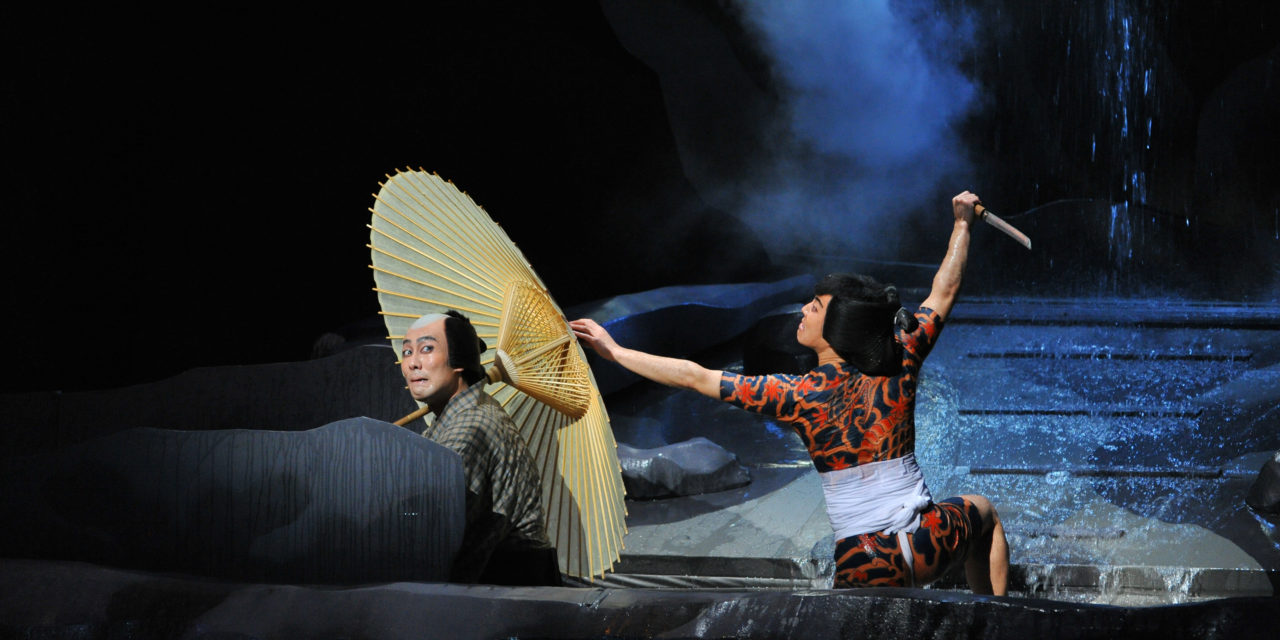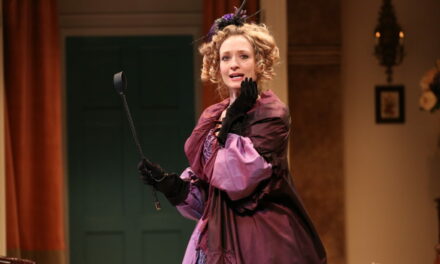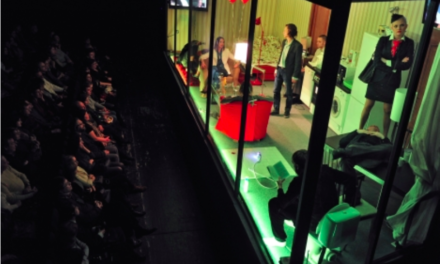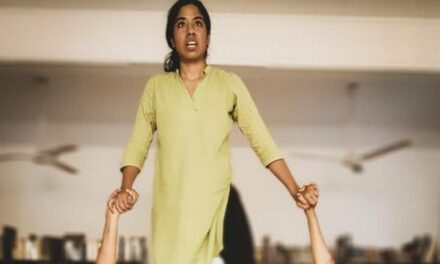In 2014, Marcina Zaccaria wrote about The Lincoln Center Festival, including productions of Genet’s The Maids and Heisei Nakamura-za’s Kaidan Chibusa no Enoki.
The Lincoln Center Theater Festival celebrates the opera, music, theatre, and ballet. With productions of Genet’s The Maids from the Sydney Theatre Company and riveting Kabuki theatre from Heisei Nakamura-za, the Festival features innovative performance styles. The Lincoln Center Festival provides a glance at art and theatre making from Western and non-Western perspectives. With groundbreaking scenography, choreography, and drama, theatre is celebrated and re-invented each year at the festival.
The Lincoln Center Festival has been in existence since 1996 (Center, 2014). The 2014 festival ran from July 7 – August 16. Artists performing in the 2014 festival came from Japan, Australia, Belgium, and Russia. Its predecessor was called The Serious Fun! Festival, an event that brought downtown, avant-garde artists uptown to Lincoln Center. Since then, the Festival has had a more international focus, offering world class performance.
With audiences from around the world, it can be a splendid event with an unmistakable sense of scale. The Lincoln Center Festival utilizes venues that include the David H. Koch Theater, The Rose Theater, and New York City Center. This year, surrounding grounds included the Japanese Artisan Village, located on Lincoln Center’s Josie Robertson Plaza just outside David H. Koch Theater. The village included handicrafts and clothing.
Eastern and Non-Western theaterr performances are not to be missed. In terms of seeing Asian art, Heisei Nakamura-za features some of the most impressive Kabuki theater in the world. Heisei Nakamura-za’s current production, Kaidan Chibusa no Enoki (The Ghost Tale of the Wet Nurse Tree), was a revelation. The performance was held from July 7th – 12th at the Rose Theater at Lincoln Center.
The power and beauty on the stage was uncommon, and the scenography doesn’t disappoint. Using images of the landscape in the background, the company clearly and delicately depicts a world where drama can thrive. Instead of a history play, Heisei Nakamura-za presented a “kaidan” or ghost story (Cavaye, 2014). This kind of drama lends itself to a Summer Festival, where beauty and grace find form. The old sets, attention to detail, and splendor of the popular waterfall are all part of the production. The scary story takes place during the hottest months of the year. The flow and the formality create a lasting impression.
The play has a surprising history. According to the Playbill program, the play is based on a rakugo solo narrative created by Sanyutei Encho (Cavaye, Heisei Nakamura-za, 2014). It was published by a Japanese newspaper in 1889. In 1915, other characters were added to the drama by Jitsukawa Enjaku II, a Kabuki actor. In 1990, the play was revived by the Kabukiza Theatre. Nakamura took on demanding roles with performances at the Shimbashi Enbujo Theatre. Particularly impressive is seeing how their theatre stands the test of time.
Using spectacle, recognizable types as characters, dazzling sets, and soundscapes, the audience felt transported to Japan. It is an imaginative, visionary world. The production at Lincoln Center utilized many elements used in the classical Japanese drama. Characters like the samurai were celebrated. Musicians were placed along either side of the theatre. Actors used kesho or kabuki makeup (Kabuki, 2014). In the past, rice powder created a white base. Then, broad lines around the eyes create definition and contour.
After 1603, Kabuki became a form of popular entertainment. In periods throughout history, rival troupes performed before the Imperial Court (Kabuki, 2014). Heisei Nakamura-za was founded in 2000 by Nakamura Kankurô, one of Japan’s leading Kabuki actors. Their practice calls upon earlier traditions. Heisei Nakmura-za frequently tours and has had performances in Toyko, Osaka, Asakusa, and Masamoto. Previous performances were held in a theatre built in the precincts of the Nagoya Castle (Heisei Nakamura-za, 2014).
This year, 2014, marked the company’s return to Lincoln Center. The show was accessible, and the audience had the possibility of using listening devices for translation. According to Kabuki21, the company used to perform outdoors (Heisei Nakamuraza). They set up an outdoor theatre in the square in 2004. Similar performances had been held during a Tokyo performance in the Sumida River.
Kabuki in Japan became an all-day theatrical event. Kaidan Chibusa no Enoki (The Ghost Tale of the Wet Nurse Tree) at Lincoln Center lasted a few hours, and though the show was long, it never seemed tedious. In fact, there were great moments of conflict and recognition. Performers come from the sides of the stage and present to the audience with expression and triumph. There was also much good humor in the piece. Moments are levity were frequent, throughout the play, as were moments of dynamic outbursts. Not lost in tradition, but rather alive and bold, the actors held their place and their position on the stage. The drama in the performance comes from action, but it also comes from tension.
While the pace of the show isn’t exactly jubilant, it is a bit too energetic to be meditative. The choreographic movement was effortless. Dramatic entrances and exits were made from either side of the stage. Entrances were joyful, and performers were like clowns giving their energy to the audience. A large cast, with over 15 performers propelled the drama. Singing was infrequent.
With perfect movement, extraordinary kimonos, and great folding walls, the company presented a story that was a feast for the eyes. The greatest drama onstage happens in a waterfall. The waterfall is placed at the Juniso Shrine. Battles are common, and the climactic scene happens when Kankuro fights his opponent. The ghost finally kills Sanji in the waterfall. The waterfall shrine was a popular setting used in the Edo period, from 1603-1868 (Heisei Nakamura-za, 2014). According to Wikipedia, the Edo period was defined by “extravagance and bombast” (Kabuki, 2014). In addition to bold costumes, the Edo period also featured keren (stage tricks) and strong mie (poses).
Theatre over the years has a heritage and a tradition that makes increasing sense over time. There is the possibility to see yourself on stage during a Kabuki performance. A Japanese and American crowd attended the performance at Lincoln Center. In the heart of the warrior or with your friends at a scene at a teahouse, there is the possibility for great empathy. Seeing this Asian piece of work is a revelation for people who have only read about Kabuki theatre.
Interdisciplinary art has delighted audiences for centuries, but this production looks fresh and calculated. The company is particularly reverent, and while Kabuki isn’t a faith based practice, it does have all of the elements of good drama. Kaidan Chibusa no Enoki (The Ghost Tale of the Wet Nurse Tree) fits within the spirit of The Lincoln Center Festival, evoking a time honored tradition and keeping it alive and vibrant onstage. The representative of the best of Eastern drama, it is poignant and reflective.
A festival like The Lincoln Center Theater Festival poses challenging arguments about the forms that power and beauty can take. In looking at the reflective culture, do we see a more authentic image or a bastardization of what has happened before? Is it a place for intellect and beauty to shine, revealing the inner nature of characters?
As theater is often defined as a “seeing place,” it is an important space for reflection. Do we see something new in the retransmission or are we following an upsetting vision of what has come before? As new concepts are re-transmitted, older concepts stand the test of time.
The Lincoln Center Festival brings together the newest technologies and the oldest forms of drama. Each year, the festival presents fresh interpretations from world class companies. Elevated concepts find form at the festival, and works that we know have new life. Eastern and Western art forms thrive at The Lincoln Center Theater Festival.
As the drama unfolds, recognition can be found. The theatre is not so much a place for alienation or stagnancy, but rather for new ideas and old forms to be appreciated and challenged by American and international audiences. Theater proves to be revelation, and in the surprising performance, there is space for outstanding drama and new, scenographic and choreographic possibilities.
This post was written by the author in their personal capacity.The opinions expressed in this article are the author’s own and do not reflect the view of The Theatre Times, their staff or collaborators.
This post was written by Marcina Zaccaria.
The views expressed here belong to the author and do not necessarily reflect our views and opinions.


















